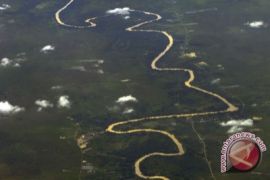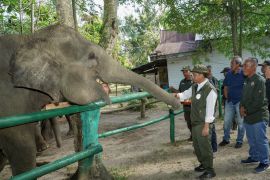"Indonesia has successfully reduced the number of forest fires over the past three years, and this year, the government is determined to do a similar thing as the National Meteorological, Climatology and Geophysics Agency (BMKG) has predicted a prolonged drought since May," the forestry ministry`s Forestry Protection and Nature Conservation Director General (PHKA) Darori said here on Wednesday (Sept 7).
The government has anticipated forest fires by among other things allocating funds amounting to about Rp160 billion to tackle forest fires in ten provinces.
Darori said earlier that the number of hot spots in Indonesia since the January 2011 were 8,082.
"The hot spots in Indonesia are found in six provinces which are prone to forest fires, and the highest is recorded in Riau with 2,159 hot spots, West Kalimantan 809, North Sumatra 600 and Central Kalimantan 543, Jambi 455, and South Kalimantan 259 hot spot," Darori said.
Around 77 percent of forest fires in Indonesia have occurred in plantation and agricultural areas, and only 23 percent in forest area, as fire has been considered the cheapest, fastest, and most effective a land clearing method.
In general, fires in peat land area were set intentionally. "The fires are due to illegal logging, plantations, and land clearing for agriculture purposes," he said.
Darori stated that the forestry ministry is ready to deal with forest fires currently occurring on Sumatra and Kalimantan Islands.
The government has emphasized preventive measures by urging the community not to use fire as land clearing methods, according to the director general.
The coordination with the regional administration authorities has also been intensified because most of the fires are located outside forest area under the responsibility of the regional administrations, Darori said, adding that he regretted, however, that the funds allocated by the regional governments for forest fire handling were too small.
As the number of forest fire hot spots is increasing in this current dry season, the central government has decided to deploy personnel to help put out the fires.
Forest Fire Operation Teams were sent to three provinces - South Sumatra, Central Kalimantan and Riau, from Jakarta on Thursday.
"The forest fire operation team will be working for three months," Coordinating Minister for People`s Welfare Agung Laksono said when seeing off the departure of the teams at Halim Perdanakusuma airport, eastern Jakarta.
Forest fire hot spots in swamp and peat land areas are particularly rampant in Jambi, South Sumatra, and Riau Provinces known as the triangle of forest fires in Indonesia.
"In Jambi, the forest fires hit Muaro District, and three peat land spots at the Berbak National Park conservation area," Darori said, adding that a human-induced fire razed around 8,000 hectares of Kerinci Seblat National Park in Jambi Province.
The Jambi fire has entered the first level status of alert because it has spread from around 500 ha last week to more than 1,000 ha currently.
The fire hot spots were detected in 12 peatland locations, including three inside the Berbak National Park in Tanjung Jabung Timur District, and one inside protected peat forest area in Tanjung Jabung Barat District.
The forest fires have been going on since two months ago in Jambi and South Sumatra.
The transitional condition from dry season to rainy season has triggered the hot spots in Riau as the temperature was quite high, according to Yudhistira Mawaddah, an analyst of the Riau Meteorological, Climatology and Geophysics Agency (BMKG) .
On Tuesday (Sept 6) alone, the US NOAA (the US National Oceanic and Atmospheric Administration) satellite detected a total of 73 hot spots on Sumatra Island, including 20 hot spots in Riau Province.
The number significantly increased from only three hot spots in Riau on the previous day (Monday, Sept 5), Yudhistira said in Pekanbaru on Thursday (Sept 8).
In addition to the 20 in Riau Province, there were also 12 hot spots in Jambi Province, two in Aceh Province, three in West Sumatra Province, three in Lampung Province, and one each in North Sumatra and Bengkulu Provinces, he said.
And the highest number of hot spots was found in South Sumatra, namely 31 hot spots.
In Central Kalimantan Province, 40 forest fire hot spots were detected in Kotawaringin Timur District, by Terra and AQUA satellites between August 30 and September 6, 2011.
"The 40 hot spots indicate forest and plantation fires," Ian Septiawan, the head of the Region II Conservation Section of the Regional Nature Conservation Agency (BKSDA) said in Kotawaringin Timur on Wednesday (Sept 7).
The number of hot spots, however, had decreased lately due to rainfall. Previously, the Terra and AQUA had detected 188 hot spots during the August 19-26 period in Kotawaringin Timur, he said.
Most of the hot spots were detected in large oil palm plantations and not easily put out despite rainfall, he explained.
"The regional and provincial governments in Central Kalimantan have so far blamed local people for the forest fires. In fact, the main perpetrators of forest fires are large oil palm plantations which have so far escaped legal sanctions," he said.
During the current dry season, hot spots have been detected in six provinces prone to forest fires, namely Riau, West Kalimantan, North Sumatra, Central Kalimantan, Jambi, and South Kalimantan.
The latest fires are currently razing on the slope of Mount Sumbing in Central Java Province, and at Panaikan village in South Sulawesi.
Forest fires caused by plantations and traditional farming methods have been blamed for the choking haze which shrouds the region annually during the dry season.
Given the increasing number of fire hot spots in the country, Rofi Munawar, a member of the House of Representatives (DPR RI)`s Commission IV, has urged the government to tackle the fires seriously.
The government must be on alert to prevent business-driven forest fires and must not work half-heartedly, Rofi, a member of the Prosperous Justice Party (PKS) said in Jakarta on Thursday.
It was possible that the commercial fires had been started intentionally to clear land for plantation or mining businesses, he said.
"The forestry ministry must act fast to anticipate more hot spots and to prevent the fires from spreading out of control," Rofi said.
As most of the fires were human induced, the government must intensify environmental campaigns, empower local people and improve the economic condition of people living surrounding forest area, the legislator urged.
"The worst disaster where the number of hot spots reaching up to 146,264 in 2006, must not be repeated," he said.
Indonesia`s forest area reaches over 130 million hectares, the world`s third largest after Brazil and Congo. In 1982-83 and 1994, El Nino-induced forest fires had destroyed around 6.4 million hectares of forest, especially in East Kalimantan. (*)
Reporter: Fardah
Editor: Aditia Maruli Radja
Copyright © ANTARA 2011











